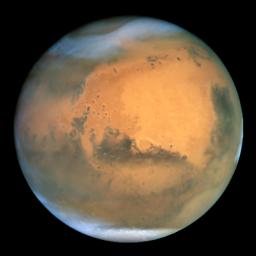
|
Mars at 43 Million Miles From Earth
- Click the image above for a larger view
- Full-Res JPEG (500 x 500) (17.9 kB)
- Full-Res TIFF (500 x 500) (750.5 kB)
Caption:
Frosty white water ice clouds and swirling orange dust storms above a vivid rusty landscape reveal Mars as a dynamic planet in this sharpest view ever obtained by an Earth-based telescope.
NASA's Earth-orbiting Hubble Space Telescope took the picture on June 26, 2001 when Mars was approximately 43 million miles (68 million km) from Earth -- the closest Mars has ever been to Earth since 1988. Hubble can see details as small as 10 miles (16 km) across. The colors have been carefully balanced to give a realistic view of Mars' hues as they might appear through a telescope.
Especially striking is the large amount of seasonal dust storm activity seen in this image. One large storm system is churning high above the northern polar cap [top of image], and a smaller dust storm cloud can be seen nearby. Another large dust storm is spilling out of the giant Hellas impact basin in the Southern Hemisphere [lower right].
Hubble has observed Mars before, but never in such detail. The biennial close approaches of Mars and Earth are not all the same. Mars' orbit around the Sun is markedly elliptical; the close approaches to Earth can range from 35 million to 63 million miles.
Astronomers are interested in studying the changeable surface and weather conditions on Mars, in part, to help plan for a pair of NASA missions to land rovers on the planet's surface in 2004.
The Mars opposition of 2001 serves as a prelude for 2003 when Mars and Earth will come within 35 million miles of each other, the closest since 1924 and not to be matched until 2287.
Cataloging Keywords:
| Name | Value | Additional Values |
|---|---|---|
| Target | Mars | |
| System | ||
| Target Type | Planet | |
| Mission | Hubble Space Telescope (HST) | |
| Instrument Host | Hubble Space Telescope | |
| Host Type | Space Telescope | |
| Instrument | ||
| Detector | ||
| Extra Keywords | Atmosphere, Color, Dust, Impact, Storm, Water | |
| Acquisition Date | ||
| Release Date | 2001-06-26 | |
| Date in Caption | 2001-06-26 | |
| Image Credit | NASA/The Hubble Heritage Team (STScI/AURA) | |
| Source | photojournal.jpl.nasa.gov/catalog/PIA18184 | |
| Identifier | PIA18184 | |
